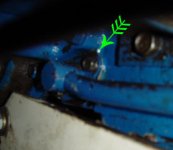Mundy
Silver Member
- Joined
- Nov 19, 2007
- Messages
- 112
- Location
- Swartz Creek, Michigan
- Tractor
- Satoh Beaver 4X4, Scag Super Z
I have been wanting to add a seperate pump to power my FEL. The 4 GPM that my tractors pump puts out at 2700rpm is a little slow and I don't like to rev the tractor that much just to move the FEL faster.
I have worked out that I have room to add a pump to the front of the tractor between the bumper rails. There is already a pre formed hole in the radiator suport for a shaft.
Now for my question:
I would like to share the Hydraulic fluid that the tractor already uses for its own system with this additional pump.
I am thinking about tapping into the supply line already running to the tractors pump to also supply the new pump.
What problems do you guys see with this?
1) The tractors pump will only be powering the 3pt after the new pump is installed.
2) This current pump supply line is approx 7/8" and the presure line leaving the tractors pump is less than 1/2".
3) The return from the new pump would be tapped into the tank at its own location.
4) The new pump will be no more than 10 GPM.
What size line is common to supply a 10GPM pump?
Would too small of a supply just starve the pumps a little and reduce the output or would it cause damage?
Would it make a differnce if the tap into the supply was closer to the tank?
I have worked out that I have room to add a pump to the front of the tractor between the bumper rails. There is already a pre formed hole in the radiator suport for a shaft.
Now for my question:
I would like to share the Hydraulic fluid that the tractor already uses for its own system with this additional pump.
I am thinking about tapping into the supply line already running to the tractors pump to also supply the new pump.
What problems do you guys see with this?
1) The tractors pump will only be powering the 3pt after the new pump is installed.
2) This current pump supply line is approx 7/8" and the presure line leaving the tractors pump is less than 1/2".
3) The return from the new pump would be tapped into the tank at its own location.
4) The new pump will be no more than 10 GPM.
What size line is common to supply a 10GPM pump?
Would too small of a supply just starve the pumps a little and reduce the output or would it cause damage?
Would it make a differnce if the tap into the supply was closer to the tank?

